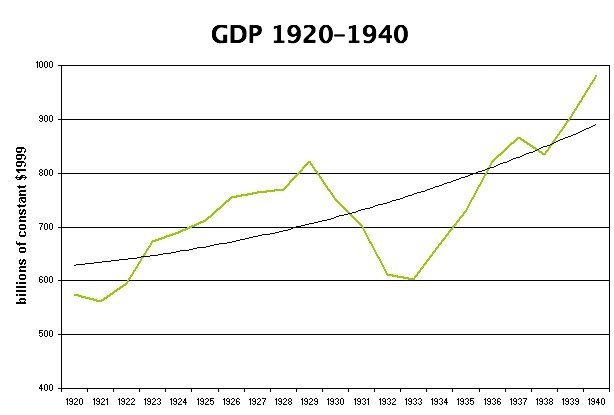Quote:
Originally Posted by Urbane Guerrilla

And no looking by any debater here into GDP 1941-45, or where it was in 1946? What do you suppose we might find? Seems those figures would support my claim about what the combination of war production infrastructure and no destruction would do, would they not?
It's easy to find GDP growth rate more than doubling 1941-45. Growth slumped a bit from '45-50, but growth rate took an upward trend thereafter.
Actual GDP in constant billions can be seen in this Wiki graphic: GDP over the Depression. What's striking is the similar angles of slump and of recovery over time. I wonder if there might have been a way to steepen the recovery curve, or not? |
UG....thanks for the Wiki graphic

It clearly shows the significant drop (negative growth) of GDP in the years '29-'32 (causing the Great Depression) and
the turn around beginning in '33, the same time the New Deal spending and job creation programs begain to be implemented, and growing annually in the pre-war years, with the exception of '37, when FDR cut back on the New Deal spending.
I dont dispute the facts that the GDP continued to rise during WW II and the post-war years.
But I am still trying to understand how WWII, rather than the New Deal spending and job creation programs, contributed to preventing further economic decline or accounted for the economic growth that took the country out of depression in FDR's first two terms (33-40)
An economic recession (or depression) is measured in quarters (or years) of negative economic growth.
As your chart illustrates, the
negative economic growth ended with the implementation of the New Deal programs that FDR introduced in his first 100 days and started funding by mid-to-late '33.....well before WW II.
I'm not suggesting the depression ended immediately with the New Deal jobs and spending programs.....but the negative growth did and further economic decline was prevented.
And the steady annual economic growth in the subsequent 5-8 years (before WW II) with the New Deal jobs and spending programs effectively ended the Great Depression by the time the US entered WW II.